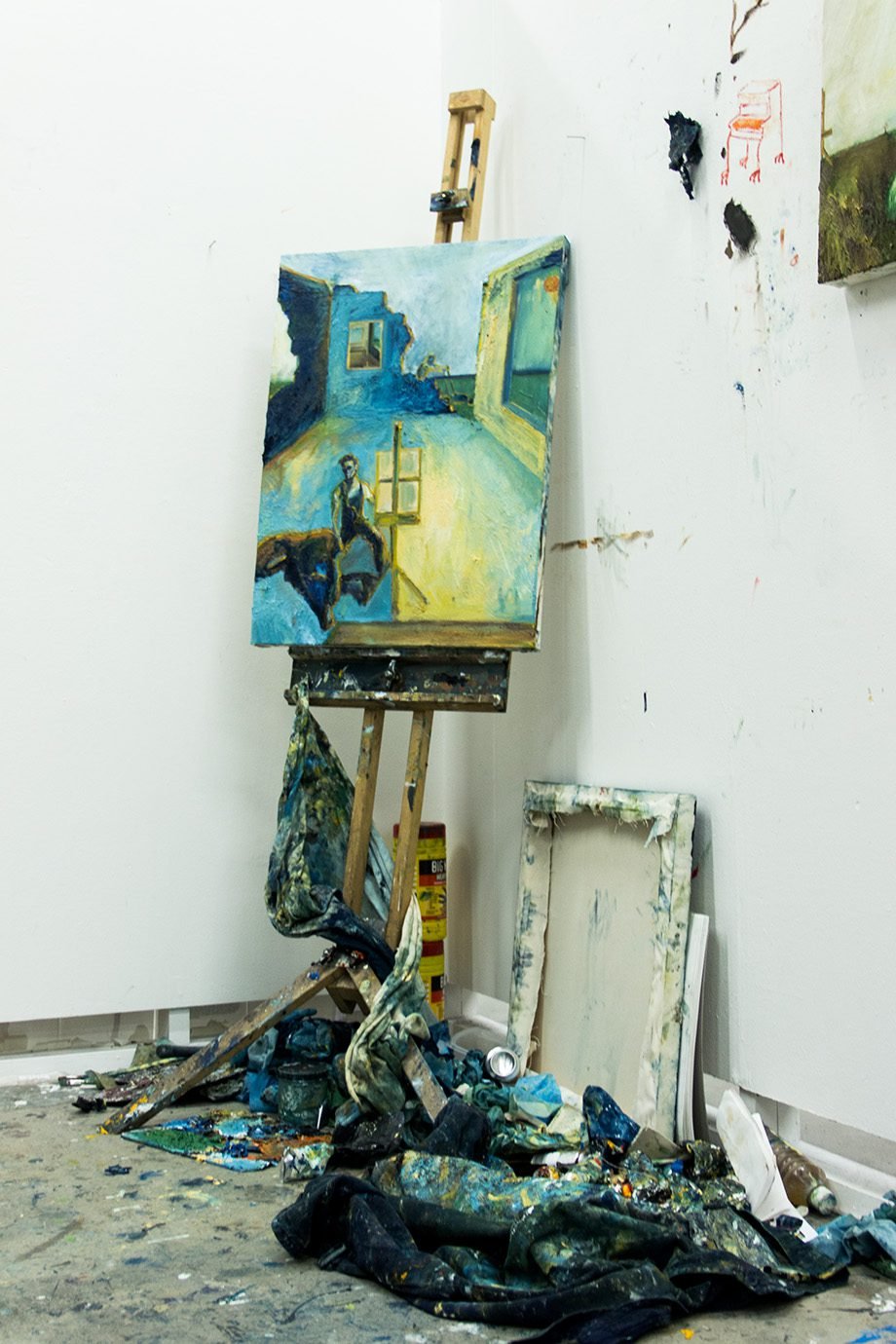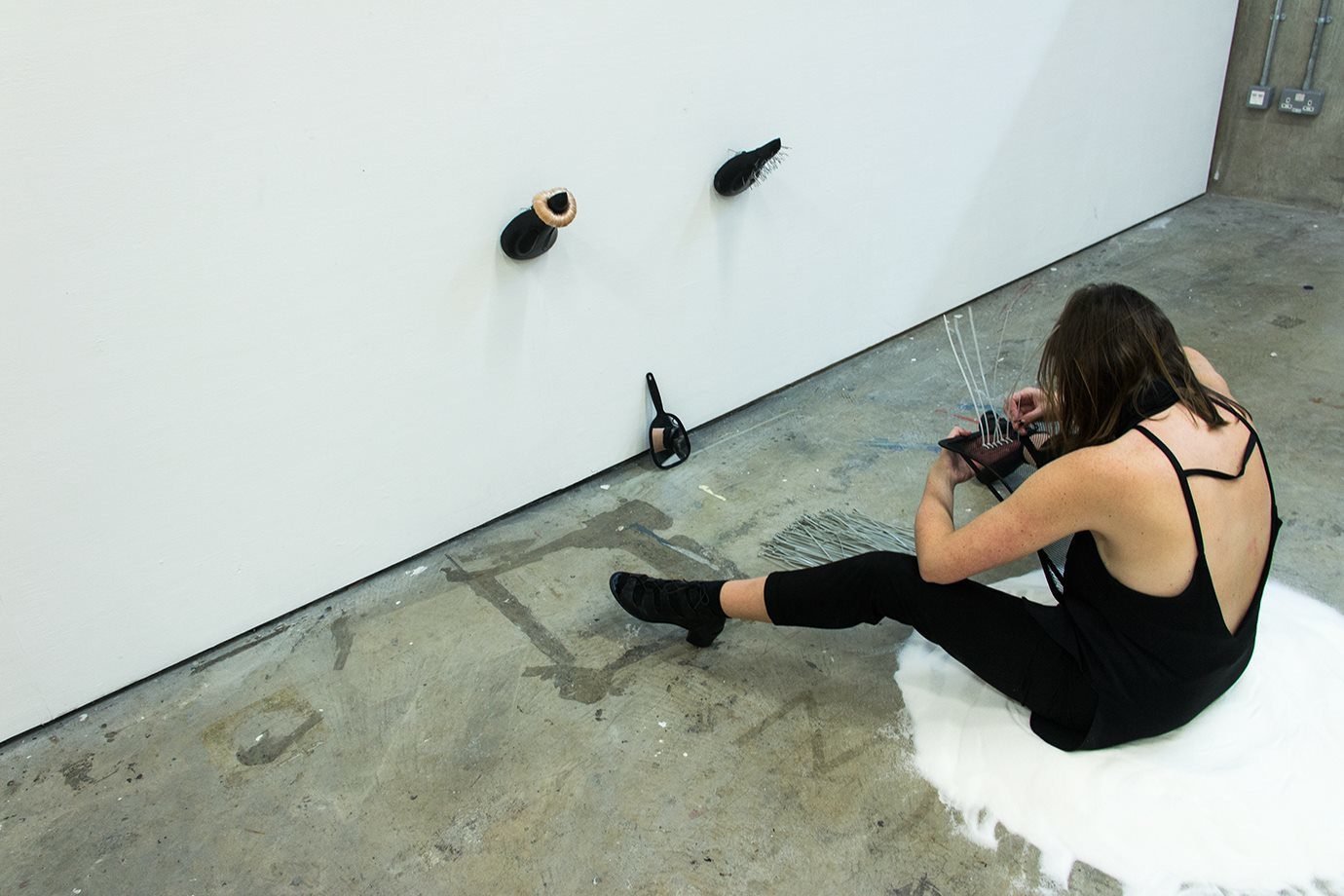I’m interested in learning more about your process from a practical perspective. Could you take us through the last shoot you did?
That was for MCQ, the BREATHE icon. What the directors wanted was for it to feel like the outside. So we hired props that would indicate the outdoors environment, like traffic lights, a lamp post – all of these elements that we could have on the day to help tell that story. The U-shaped green area in the video was a little more playful but challenging because we had to cover one side of this structure with rocks. I thought that surely 10 bags of rocks would be enough, but we ended up using 30 or 40 bags. It seemed as though there were never enough rocks. We just kept putting more on and we ran out very quickly. You’re there like, “Damn, I thought I had enough.” I think I spent three days in B&Q back and forth just being like, “Yo, I need more rocks.”
The idea was for the rocks to be round and pebbly but we couldn’t get exactly that because that was too perfect. We ended up having to go with what was available at the time. Obviously, these things happen really quickly. You don’t have enough time for things to arrive so in the majority of these kind of projects it’s more of a reaction. We don’t have the luxury of having the time to overly prepare something. You have to see what’s available to you at the time. If you can get the exact thing – amazing. If you can’t, then you need to get something else close to that.
Initially, we had the idea of using fake grass but I wasn’t a massive fan because sometimes it can look really fake. For this, we wanted there to be a naturalness to it. We ended up deciding that real grass would tie in a lot better with the whole story and the whole iconography of the collection. On top of that, we had to cut these lines into the grass. That was quite challenging because I thought we could use hair clippers to cut it. My team was like “no, it’s not the same, but ok.” I thought it would be fine. If you cut your hair with this stuff, you can cut grass with it. Then I got my razor from home. I turned it on and it didn’t do anything at all. The whole team was just standing there looking at me like “Okay, cool, we’re not gonna say anything. We’re just gonna let him go for it and look like an idiot.” [laughs] It was wonderful. I learnt a lot from it. Lesson number one: don’t try and cut grass with your hair clippers. [laughs]
“One of the interesting things about set design is that sometimes it’s scary because there’s so much that can go wrong. That’s where the excitement is. You push for that. As creatives, we love problem-solving. We love an experiment. It can go wrong but that’s fine. We learnt something from that.” – Ibby Njoya
I think it’s interesting how in these creative fields you can go very conceptual and have lots of ideas about the themes but then it really comes down to these super practical solutions.
It’s one thing having amazing creative ideas. It’s great to have those and that’s how amazing things are created but, at the same time, it falls back to how we realise these ideas. Obviously, there are going to be obstacles that get in the way or budget or time constraints. There are loads of things that are gonna be thrown at you where you need to find ways to wiggle your way around it to try and create something that not only you will be happy with but the client will also be happy with. We had problems on the day of the set up where the heat reacted to our paintings that we had created and it didn’t sit the way we wanted it to sit. On that day, the day before the shoot, we had to repaint everything. We had to start again on all of the paintings, scrap everything that we had spent three days doing. And we had to do it in an evening. It’s challenges like that that you have to loosely prepare for and then be ready to react. You can plan but you cannot plan for stuff that you don’t know will happen. It’s forever keeping some form of contingency for when shit hits the fan and you need to react. One of the interesting things about set design is that sometimes it’s scary because there’s so much that can go wrong. That’s where the excitement is. You push for that. As creatives, we love problem-solving. We love an experiment. It can go wrong but that’s fine. We learnt something from that.
“Not all of this is glamorous and fun but as long as you and the team are having a great time while solving these problems that’s fine. ” – Ibby Njoya
You also have so many people relying on you. You can’t postpone anything if there’s a shoot day with ten other people.
If something is set there’s already so much money and time that has been spent on that date. Unless something really, really bad happens you have to try and adapt. Normally if there’s an issue you need to find a solution. You don’t have the luxury for something to go wrong. You’ve got to do it. You’ve got to find a new way or another way to achieve whatever needs to be achieved. At the same time, everyone’s always like, “This is going to be great! We’re gonna do this!” My agent is really good at that. Every time I call him like, “This is going wrong,” he’s like, “Listen. Just relax. You’ve got this.” And I’m like, “Alright, cool! We’ve got this. Let’s go!”
In that way, you begin to create a solution and I think it’s also very, very important to have a good team around you. Two brains are better than one. You can get someone else’s opinion. Other people can see things that you don’t necessarily see in that moment. It’s so important. We could not have done anything we did with this shoot without the team being there and being supportive and being able to get shit done. Not all of this is glamorous and fun but as long as you and the team are having a great time while solving these problems that’s fine.
There’s that cliche of the fashion people who shout at their assistants and are mean to everyone they meet. I think this is often a result of stress and pressure. I realised how important it is to learn to take a step back and take a moment of relaxation and remind yourself that we’re here to work together and make it a nice moment.
I don’t want to say it’s justifiable to be rude to someone because it never is but there’s stuff that happens that way. It’s really hard to deal with these things and therefore you’re reacting in a way that is counterproductive for you and the entire team. For us, the way I work with my team, we’re fully looped in on as much of the creative process from the beginning as possible. Then we’re all in the loop. We know every element of the project and how it needs to be. If one person is stressed then another person can understand how we can alleviate that. We work together to try and solve whatever it is. Sometimes we’re stressed. Sometimes I’m stressed. Sometimes the whole team is stressed but the thing that keeps us going is us having a great time. I think it’s about that relationship between whoever is in charge and the rest of the team. Not making it like, “You work for me and you do this.” We’re here to work together and complete something.
“One thing that we all need or want as people is to feel like you’re valued in whatever you’re doing. ” – Ibby Njoya
You’re saying that, if you don’t just see people as executors of your idea or assistants but if you involve them in the creative process, they’re much more likely to also offer that support in times of stress.
Exactly. That’s the way I think about things. People tend to be more involved in something when they can voice their opinion and it’s heard. It becomes more valuable. One thing that we all need or want as people is to feel like you’re valued in whatever you’re doing. If whoever you’re working for makes you feel like you’re not or like you’re just there to do whatever they need you to do then I guess that’s gonna be difficult.

























